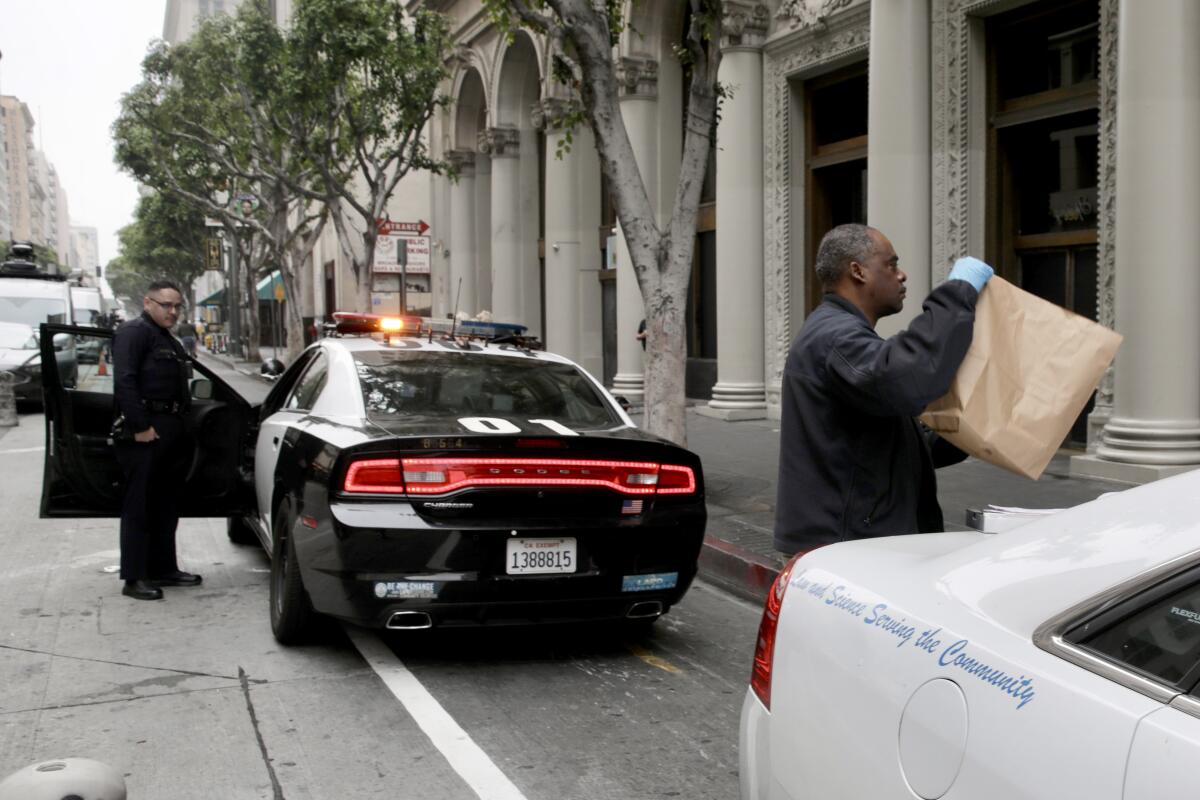Three men found dead in downtown L.A. after ingesting fentanyl, police say

- Share via
Three men were found dead in a downtown Los Angeles apartment early Thursday after ingesting fentanyl, the latest instance in what officials say is a nationwide epidemic of overdoses and deaths related to the powerful synthetic opioid.
Los Angeles police went to the apartment in the 600 block of South Spring Street after one of the men’s relatives requested a welfare check, said LAPD Officer Melissa Podany.
Officers found the men’s bodies in the apartment, she said. Firefighters and paramedics were prevented from entering the unit after officers spotted white powder near the bodies and called the Hazardous Materials Squad.
One LAPD officer was taken to a hospital after possibly inhaling the drug accidentally and was stable, Podany said.
One of the men who overdosed went by the name Mirko, said Robert Kechder, a neighbor who lived on the same floor in the apartment building.
“Whoever gave this to him, I hope they catch him because he was a good guy,” Kechder said. “He was the very first person when I moved into this building to say ‘hello’ to me and ‘how are you.’”
Mirko, who appeared to be in his 50s, worked as a DJ at a neighborhood bar, said Kechder.
Another neighbor, who did not wish to be named, said Mirko was outgoing and generous, often giving imported ham and cheese to his neighbors. The neighbor added that building residents are upset and confused by Mirko’s death.
The incident remains under investigation.
Fentanyl, which is approximately 100 times more potent than morphine, is used to treat severe pain in medical settings, according to the Drug Enforcement Administration.
In April, a 28-year-old man died and two more men were hospitalized in South Los Angeles after overdosing on drugs that contained fentanyl.
Also last month federal prosecutors charged seven people with distributing fatal doses of fentanyl that killed 10 people over the last several years in Orange County.
The case underscores the degree to which the opioid has pervaded the illegal drug market in Southern California. Most of the people who overdosed in those cases had used cocaine or counterfeit prescription pills that, unbeknown to them, were laced with fentanyl, authorities said.
California has seen a spike in fentanyl overdoses in recent years, with 3,946 deaths reported in California in 2020, according to the state Department of Public Health.
State lawmakers have responded with a list of bills that would include imposing stronger penalties for distributing the synthetic opioid and easing access to safer consumption and treatment.
One proposal would allow a sentence of up to life for distributing fentanyl that results in a fatal overdose, and would make it a felony to possess two or more grams of the drug. The measure would also add sentence enhancements for selling fentanyl in areas around children or on social media.
“There is no doubt in my mind that the fentanyl epidemic is an urgent public health crisis,” Assembly Member Cottie Petrie-Norris (D-Irvine) said at a news conference in March to unveil Assembly Bill 2246. “There is also no doubt in my mind that we have not acted with adequate urgency to address that.”
The U.S. has reported unprecedented numbers of fatal overdoses during the COVID-19 pandemic, with fentanyl far outpacing other drugs in death rate, officials said. There were 56,516 synthetic opioid-related deaths in 2020, nearly twice the number of deaths in 2018, according to data collected by the National Institute on Drug Abuse.
The American College of Medical Toxicology and American Academy of Clinical Toxicology have stated that although fentanyl is a powerful opioid, “the risk of clinically significant exposure to emergency responders is extremely low.”
More to Read
Sign up for Essential California
The most important California stories and recommendations in your inbox every morning.
You may occasionally receive promotional content from the Los Angeles Times.















